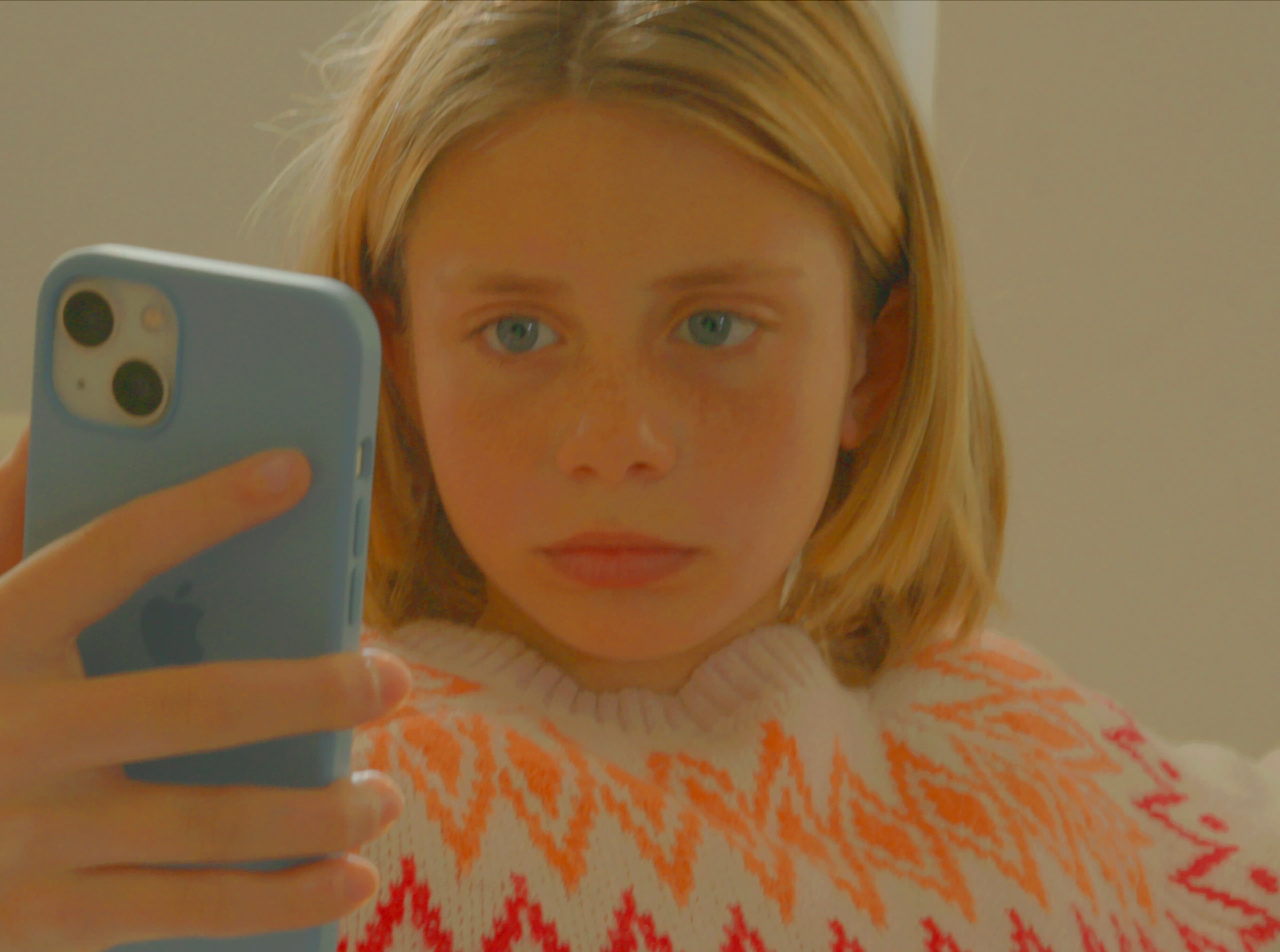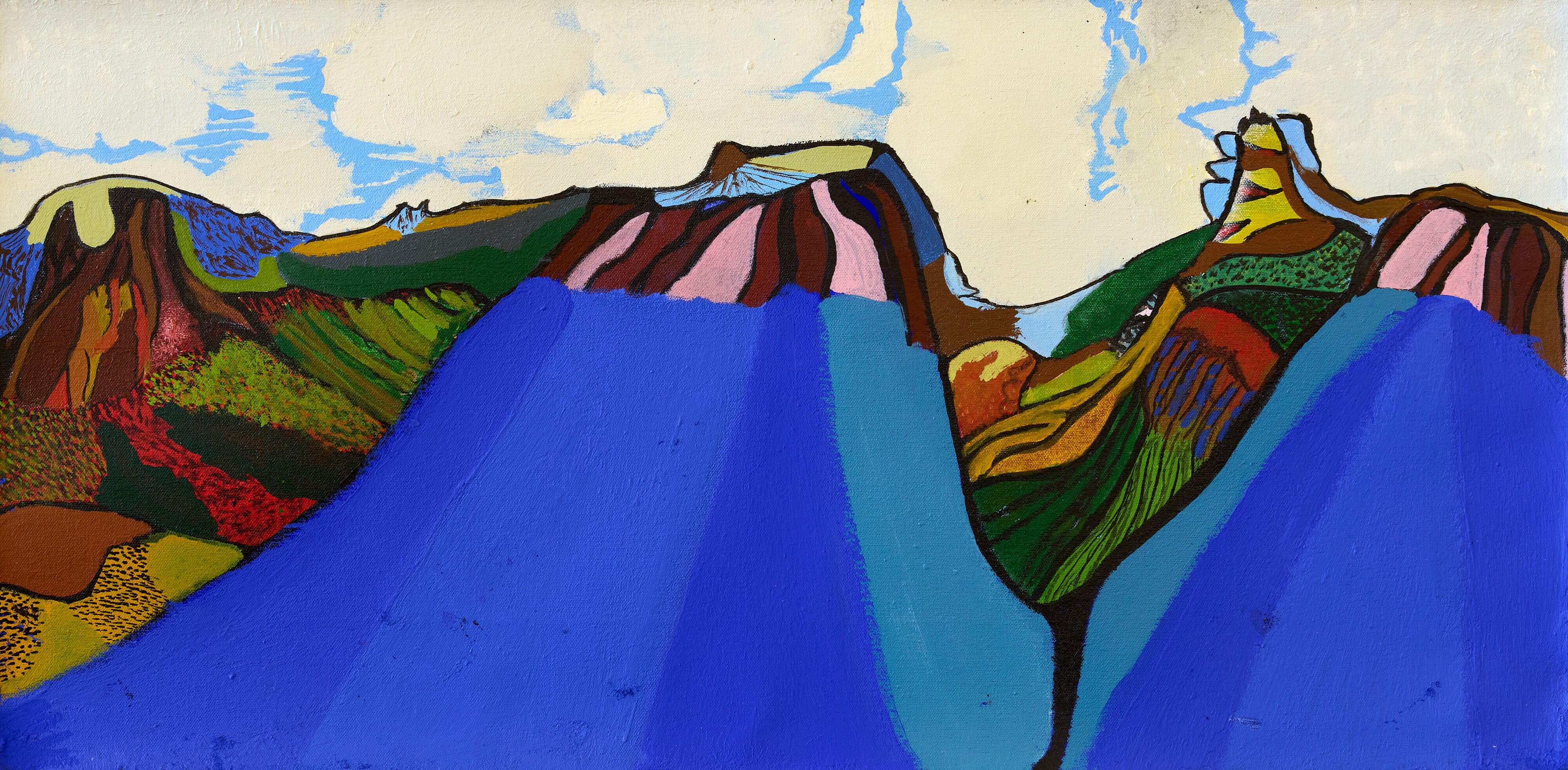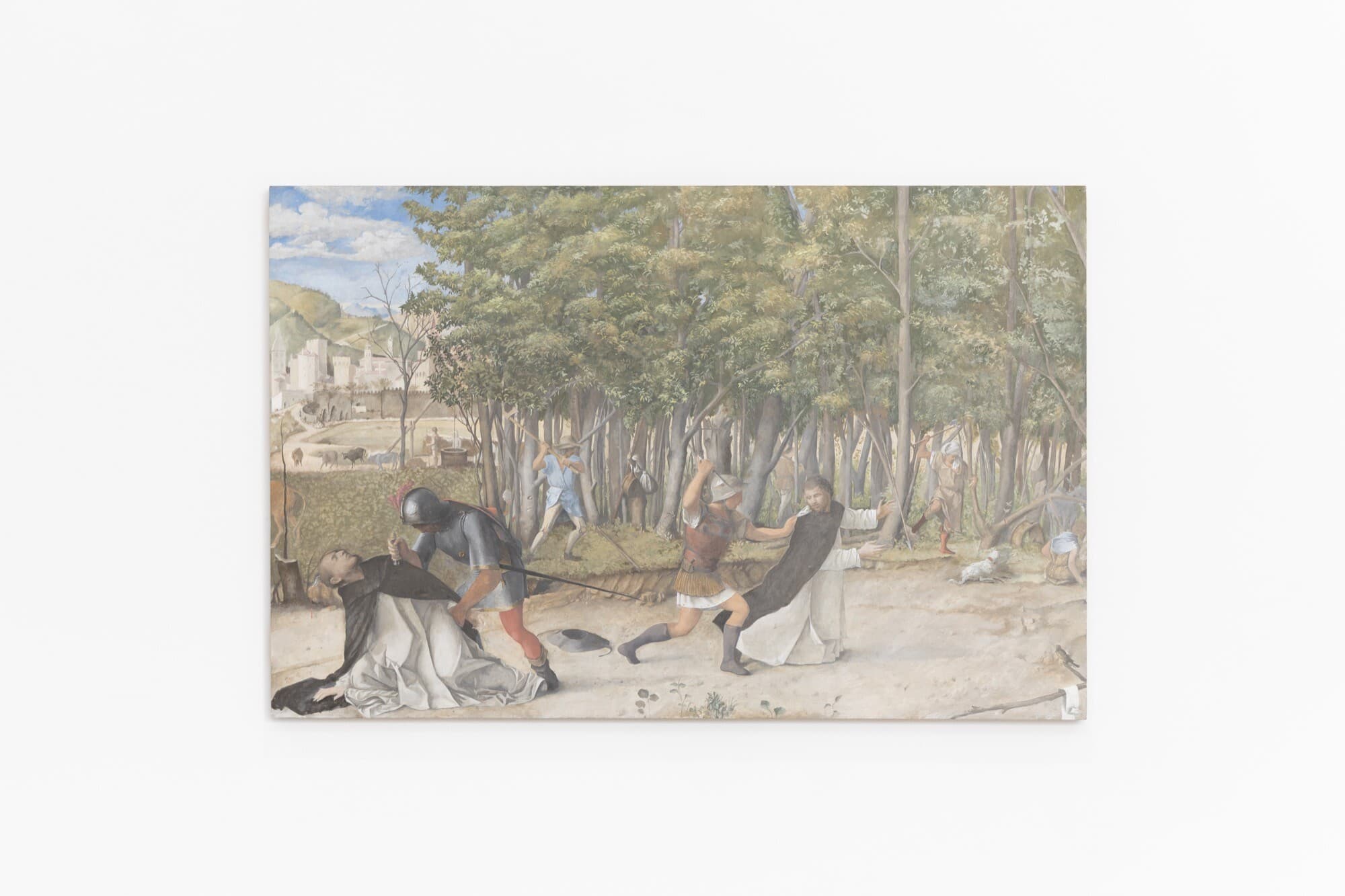HOME, Australia Pavilion, Venice Biennale of Architecture. Photograph by Peter Bennetts.
HOME
Ann Stephen
Each time I chose an entertainment option on the Emirates flight to Venice (one of the only direct flights available from so-called Australia), it would open an advertisement featuring “Trump collaborations across the globe,” showing towers, hotels, and golf courses in Jeddah, Oman, and Dubai, emblazoned with the tagline “Expect Exceptional”. It wasn’t what the 19th Venice Biennale of Architecture celebrated, but it was a reminder of the spectacles that global architecture and neo-liberal capitalism are capable of delivering. I had gone to Venice as I was co-curating a Harry Seidler exhibition at San Marco Art Centre, and while there, I seized the opportunity to visit and review Australia’s exhibition, HOME. The project, directed by an all-Indigenous team, aims to interrogate the idea of home and facilitate cross-cultural dialogue. As a non-Indigenous art historian, I thought an “outsider” review of the work might be useful to understand the forces that have been set in play at the Australian Pavilion in recent months.
The Venice Biennale, since it was launched in 1895, has come a long way from its origins in nineteenth-century colonial expositions. Architecture has only come to occupy the Giardini della Biennale independently from the art Biennale every alternative year since 1980, and even then, the first Australian pavilion designed by Philip Cox was “temporary” from 1987 until Denton Corker Marshall’s pavilion was completed almost thirty years later in 2015. Since then, some of Australia’s exhibitions have carried a futuristic theme, and most have been collaborative. Recent years—Repair in 2018 and Unsettling Queenstown in 2023—have seen Indigenous subjects, participants, and designers increasingly coming to the fore. This year, the overall theme, curated by the Italian architect and engineer Carlo Ratti, had an environmental focus, challenging participants “to face a burning world” by harnessing “all the intelligence around us,” eliminating waste with sustainable constructions and regenerative natural systems.
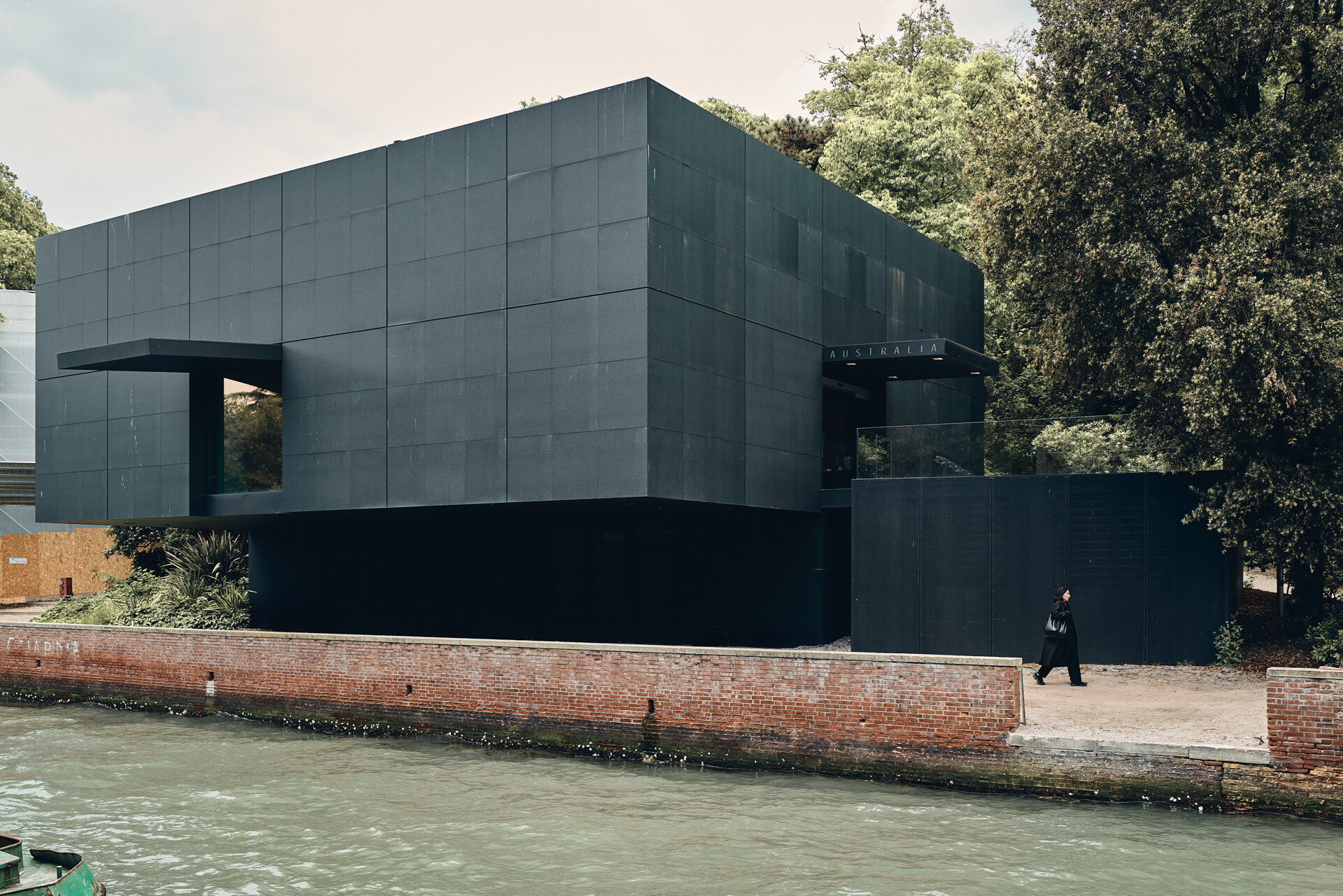
Exterior of Denton Corker Marshall’s Australia Pavilion in Venice, completed in 2015. Photograph by Peter Bennetts.
Last October, The Australian Institute of Architects Curatorial Committee, responsible for shortlisting and selecting the Creative Directors for the national pavilion, chose the first all-Indigenous team of Dr Michael Mossman (Kuku Yalanji), Emily McDaniel (Kalari), and Jack Gillmer-Lilley (Worimi & Biripi Guri). It is salutary for the art world to see that, for the architecture biennale, the selection is made by an expert panel of fellow architects and it is not, as in the case of the art biennale, a matter of the final decision lying with Creative Australia.
In February this year, when Creative Australia cancelled Khaled Sabsabi’s Venice Art Biennale project, on the basis that it posed an existential threat to “social cohesion”, it caused shock waves across the art world. In a rare show of unity, thousands of artists, curators, and others signed petitions opposing the decision, in support of the artist. While this disastrous episode overshadowed the preparation for Australia’s project for the architectural biennale this year, it has nonetheless brought into high relief the political and cultural stakes involved in such an international event, exposing flaws in the art selection process and the vulnerability of our cultural institutions at large.
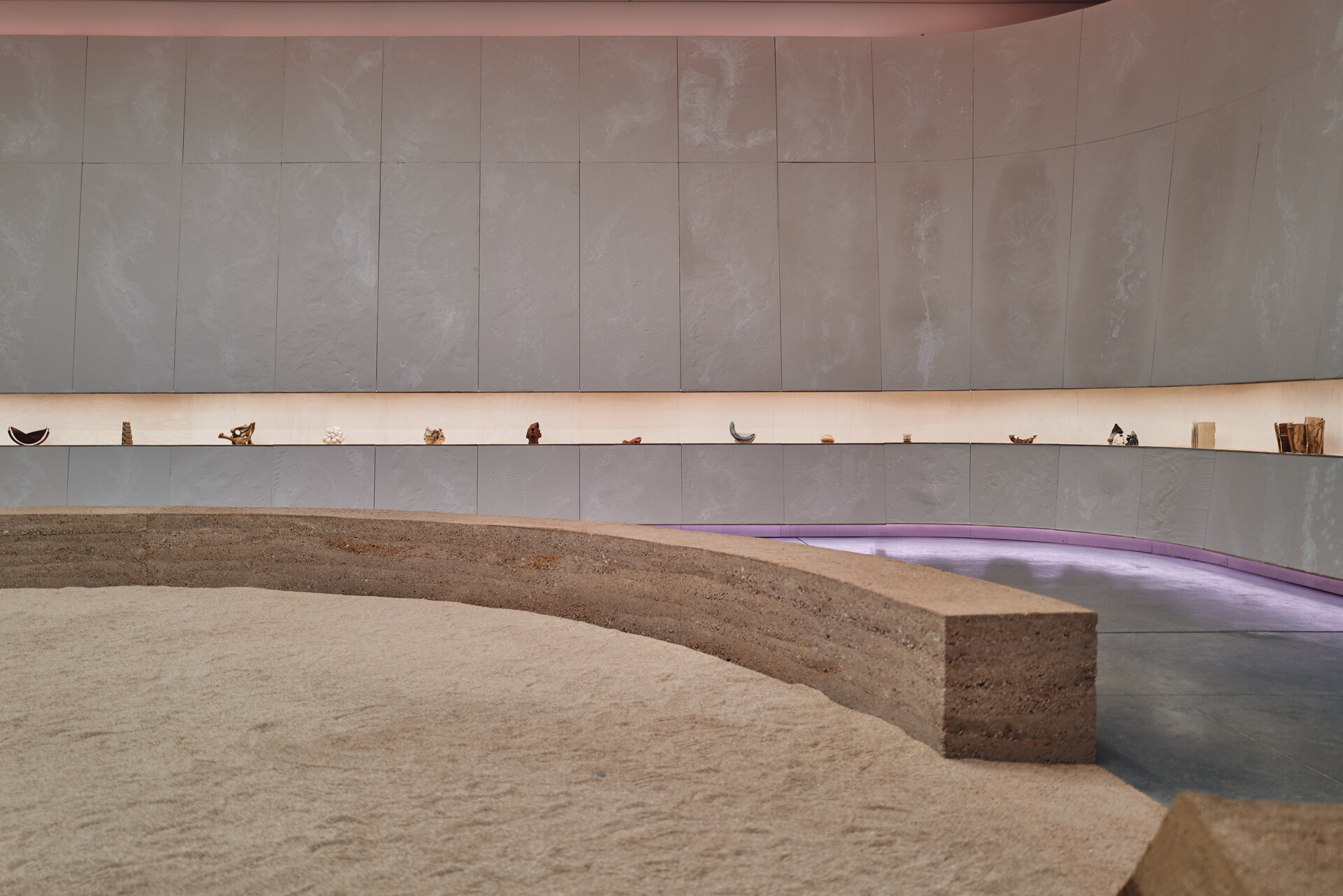
HOME, Australia Pavilion, Venice Biennale of Architecture. Photograph by Peter Bennetts.
The all-Indigenous representation acknowledges that First Nations cultures have assumed primary interest in global cultural exchanges. Yet, as creative director Emily McDaniel stresses, “this is no embassy of Australiana.” The project, HOME, was developed off the back of the divisive racist politics in Australia that led to the historic failure of the Voice referendum. Thus, Dr Michael Mossman speaks of “creating a space for dialogue and acknowledging the recent referendum. When words fail us…we turn to ceremony—to a shared moment of acknowledging the setback and moving forward together.” The concept of HOME presented here is “grounded in Indigenous knowledge systems and architectural innovation”. It is distinct from other recent Australian architectural pavilions that have sought to “decolonise” architecture. Instead, this year’s creative directors have set about Indigenising the process, working as part of a Creative Sphere collective with Elle Davidson (Balanggarra), Bradley Kerr (Quandamooka), Kaylie Salvatori (Yuin) and Clarence Slockee (Mindjingbal/Cudgenburra), who contribute skills in landscape architecture and design, horticulture, music and dance, teaching, town planning, and community engagement, and will be supported by a team of cultural mediators to staff the pavilion over the next five months.
One of the challenges for the Creative Directors in mobilising an Indigenous concept of HOME is to demonstrate a sense of caring for Country in a temporary space on foreign ground. In the pavilion, the group has created a space for performances, storytelling, and other activities, which will take place throughout the year. The design, in line with the overall Biennale theme, offers insight into how Indigenous methodologies can reshape contemporary architectural practices against a backdrop of climate catastrophe. No text nor screens clutter this interior, as their communication emphasises the experiential through the material, through the tactile as much as the visual.
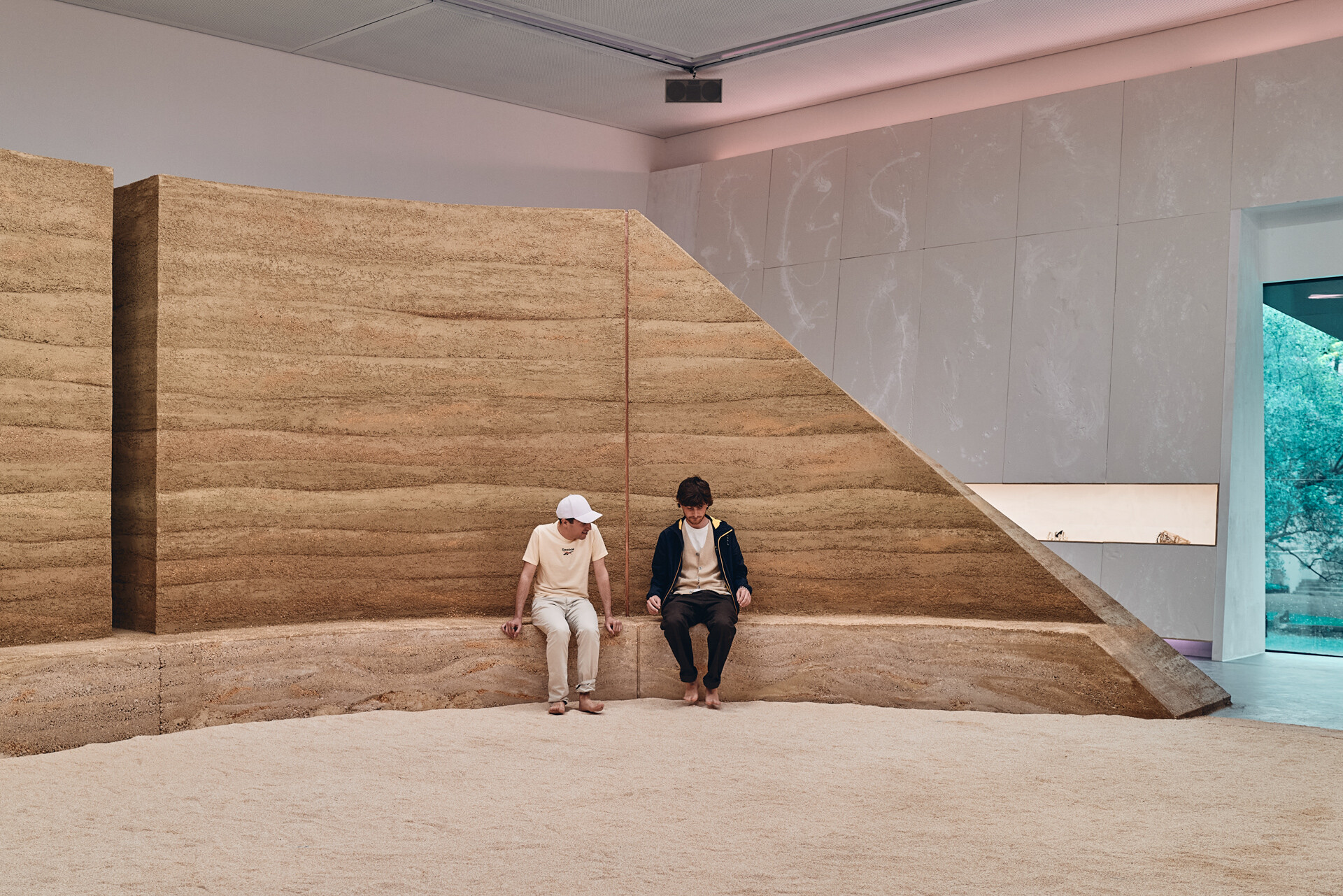
Tactility is emphasised in the HOME exhibition where viewers are invited to touch and interact with the work. Photograph by Peter Bennetts.
At the entrance to Denton Corker & Marshall’s architectural black box, the visitor confronts a semi-circular, free-standing, rammed-earth wall with a long vertical slit that offers a view into the interior. As you follow its high curved surface towards the light, the wall tapers to become a rammed earth bench completing the circle, with gaps on either side inviting visitors to sit, listen, talk or play on a large inner circle of sand. This gathering space is enclosed by the pavilion’s interior wall that has been lined with a concealed timber frame that (without nails or screws) holds in place 127 plaster of Paris panels. Dubbed “a living cloak,” this structure softens the interior’s corners while cloaking the white box. Each pale rectangular plaster sheet bears traces of their makers’ hands, for all were made and assembled on site in an extraordinary spirit of collective labour. There is a geometrical clarity of the circle in plan, centred in the space, with its symmetry seen through the long vertical slit. There is also a powerful contrast between the white custom-poured plaster panels and the inner wall of dark layers of local soil.
Two elements bring this skin to life. First is the light: two continuous strips of concealed lighting circle the space; a violet colour skirts the floor; a dusky peach, the ceiling rim. Daylight enters through the large pavilion window facing onto the canal, though the violet and peach suffuse the dark earth and light plaster walls, as if the space is held suspended in a dawn light.
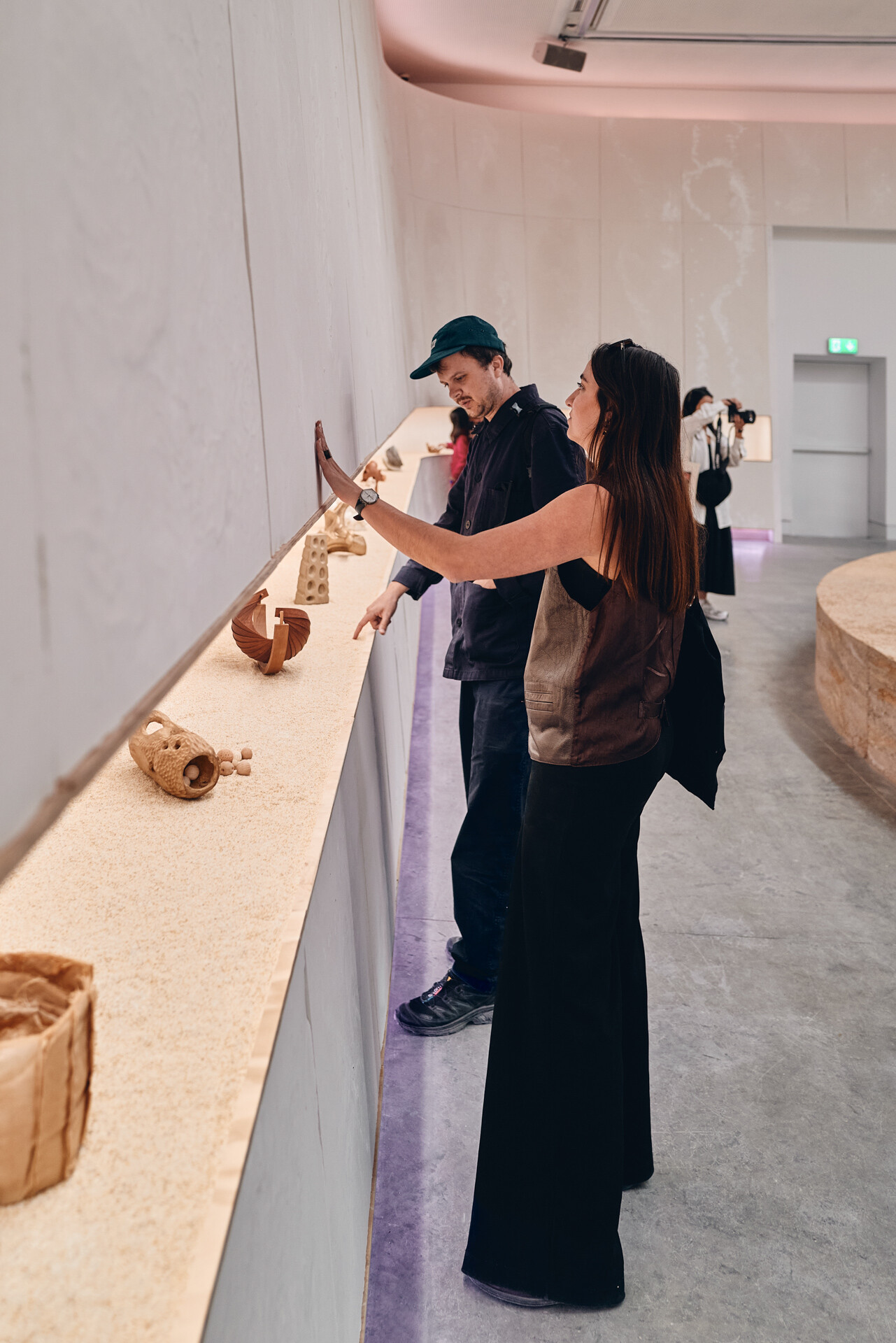
“Living Belongings” accessible on the sandy ledge of the “living cloak”. Photograph by Peter Bennetts.
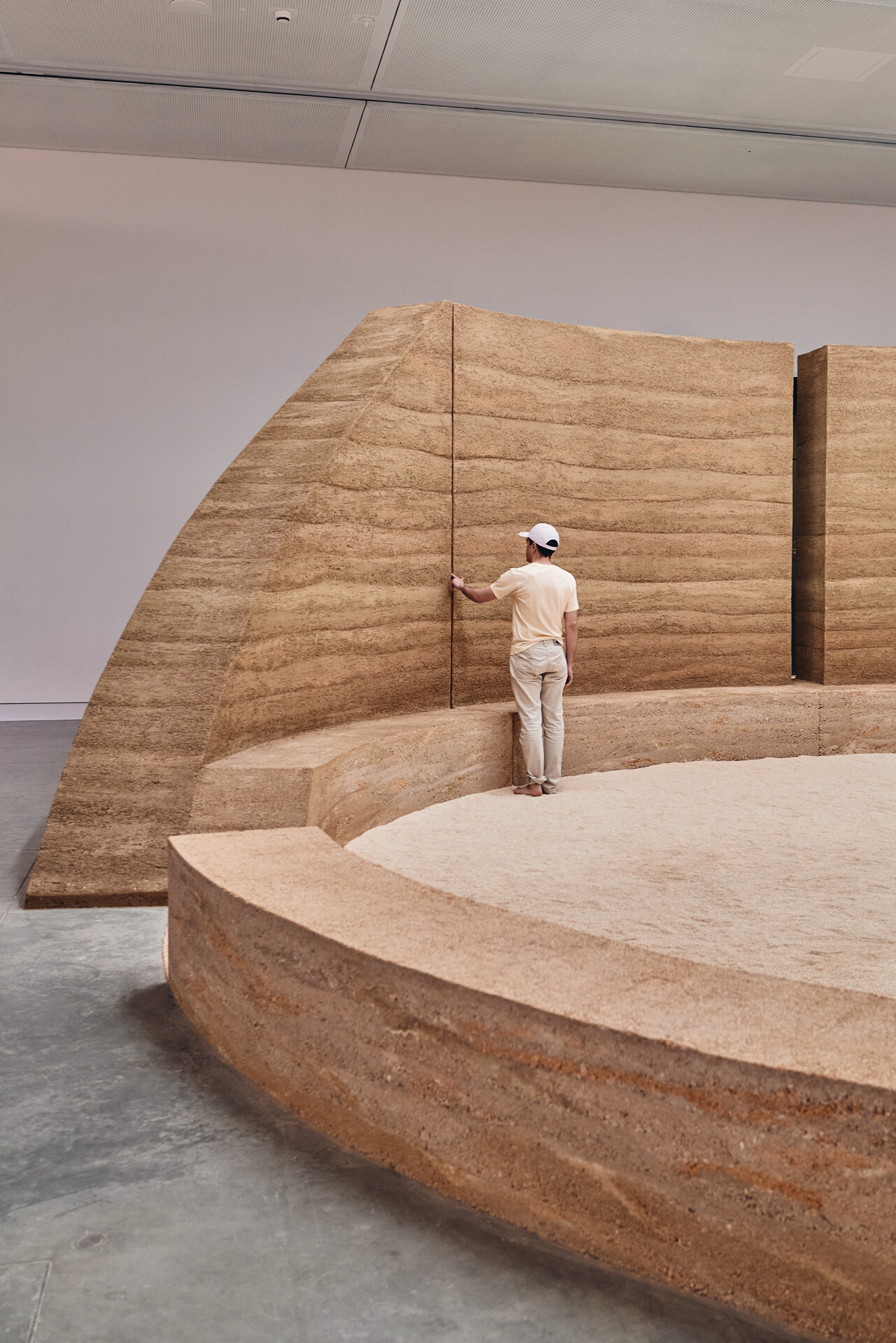
The massive rammed-earth wall and bench. Photograph by Peter Bennetts.
The other extraordinary, but also ordinary, element goes directly to the concept of HOME. An open shelf, at waist height, forms an arc in the temporary plaster outer wall. On it are displayed at regular intervals some thirty-nine objects, dubbed “living belongings.” These are the product of an intensive four-week summer school hosted by The University of Sydney School of Architecture, Design and Planning, held across eleven Australian architectural schools in a program coordinated by Elle Davidson and Dr Michael Mossman. The 118 Indigenous and non-Indigenous students who participated were asked to consider what Country means, and to give concrete expression to their sense of home, recognising the multiplicity of its meanings. Materials were to be limited to timber, clay, and plaster, though these have expanded to include natural materials such as feathers, wax, fibre, stone, and other found materials.
All these “living belongings” rest on a bed of sand with no glass separating them from the viewer; in fact, the cultural mediators who staff the pavilion encourage visitors to touch, pick up, and hold them. Here the idea of “home” and cross-cultural dialogue is brought to life through objects produced by people from different backgrounds, presented together. Not precious but intimate, each with a distinctive narrative that is revealed by a QR code. Take a timber assemblage by Anja Anders, a tight stacked timber block, like piles of books, with one side is charred, and the other sanded surface revealing that it has been made from many layers. Anders writes “understanding my home and my German heritage has meant unpacking the layers that define who I am and what makes me. Schichten can be translated to layers and Geschichten means stories.” Another titled Circles of Connection by Diego Juca De Lima Oliveira, intersects two plaster arcs, one stained dark with charcoal, the paler one stained green with Chimarrão tea, from his Brazilian heritage, as he explains: “Chimarrão is a ritual of connection, carrying memories of home… we sit in loose circles. It mirrors First Nation storytelling… You cannot have Chimarrão without fire.” One small stone tower titled Continuum Shell by Eden Wilson is beautifully carved from rock: on one side, a circling pattern; on the other side, a pattern of ovals. Wilson writes, “I found shells that were eroded through, revealing an internal structure that is completely continuous with the external structure. I decided to use this form to represent the continuum of Country… (it) contains the knowledge my Dad passed down to me.” While some pavilions show many models and didactic plans, these diminutive “living belongings” are very different, and mostly quite abstract, suggesting intimate and imaginative experiments, in the spirit of Bauhaus material investigations.
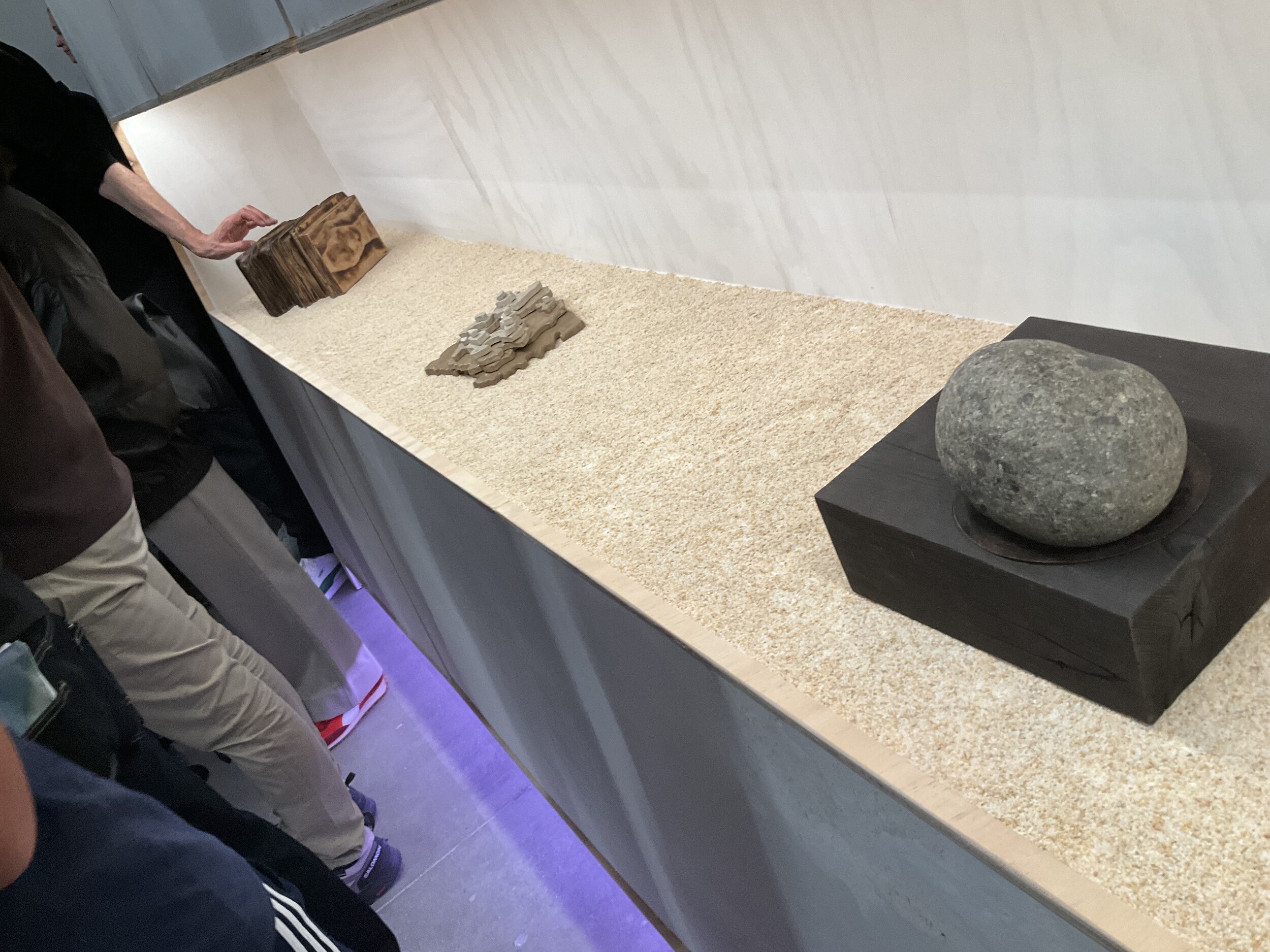
You can interact directly with the “Living Belongings” displayed on the sandy ledge. Photograph by the author.
Following the award of the Golden Lion to Archie Moore’s kith and kin pavilion in the Venice Art Biennale of 2024, artists, architects, benefactors, bureaucrats, and a wider public are more than ever focused on the significance of the Australian Pavilion. International politics frames the Biennale, as the wars in Gaza and Ukraine sharpen debates about racism and immigration. Will the Australian Pavilion be shamefully void next year during the Art Biennale, like those of Israel and Venezuela today? Or might a mature Labor government draw upon the spirit of generosity that pervades HOME and reinstate Khaled Sabsabi? This year, Dr Michael Mossman, Emily McDaniel, and Jack Gillmer-Lilley, alongside their Creative Sphere collaborators, have presented not only a space for dialogue but have shown great generosity, revealing Indigenous knowledge and cultural practice as stronger than ever. In their words, “country is a living being that we care for with responsibility and obligation.” By making the pavilion a home from home, the Creative Directors have shown Australia and the wider world how an Indigenous ethics of regeneration and sustainability has the potential to reshape our environment.
Ann Stephen is a writer from Eora Country.
